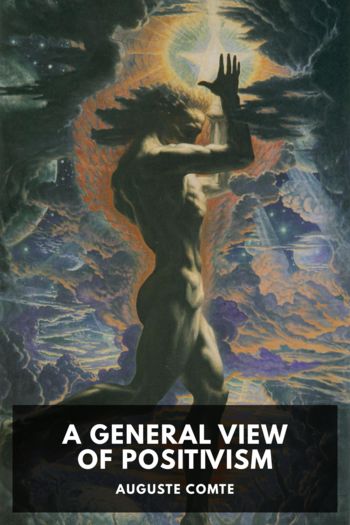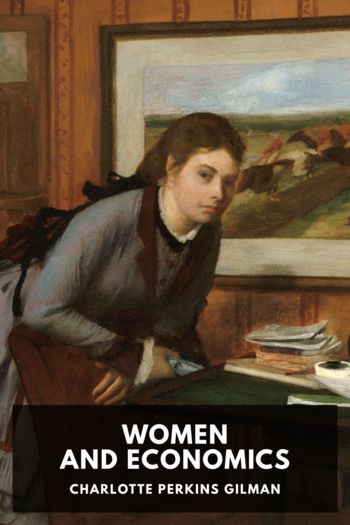A General View of Positivism, Auguste Comte [best sales books of all time .txt] 📗

- Author: Auguste Comte
Book online «A General View of Positivism, Auguste Comte [best sales books of all time .txt] 📗». Author Auguste Comte
Evidently, then, it is in Art that the unity of human natures finds its most complete and most natural representation. For Art is in direct relation with the three orders of phenomena by which human nature is characterized; Feelings, Thoughts, and Actions. It originates in Feeling; the proof of this is even more obvious than in the case of Philosophy and Polity. It has its basis in Thought, and its end is Action. Hence its power of exerting an influence for good alike on every phase of our existence, whether personal or social. Hence too its peculiar attribute of giving equal pleasure to all ranks and ages. Art invites the thinker to leave his abstractions for the study of real life; it elevates the practical man into a region of thought where self-love has no place. By its intermediate position it promotes the mutual reaction of Affection and Reason. It stimulates feeling in those who are too much engrossed with intellectual questions: it strengthens the contemplative faculty in natures where sympathy predominates. It has been said of Art that its province is to hold a mirror to nature. The saying is usually applied to social life where its truth is most apparent. But it is no less true of every aspect of our existence; for under every aspect it may be a source of Art, and may be represented and modified by it. Turning to Biology for the cause of this sociological relation, we find it in the relation of the muscular and nervous systems. Our motions, involuntary at first, and then voluntary, indicate internal impressions, moral impressions more especially; and as they proceed from them, so they react upon them. Here we find the first germ of a true theory of Art. Throughout the animal kingdom language is simply gesticulation of a more or less expressive kind. And with man aesthetic development begins in the same spontaneous way.
With this primary principle we may now complete our statical theory of Art, by indicating in it three distinct degrees or phases. The fine arts have been divided into imitative and inventive; but this distinction has no real foundation. Art always imitates, and always idealizes. True, as the real is in every case the source of the ideal, Art begins at first with simple Imitation. In the childhood, whether of men or of the race, as also with the lower animals, servile imitation, and that of the most insignificant actions, is the only symptom of aesthetic capacity. No representation, however, has at present any claim to the title of Art (although from motives of puerile vanity the name is often given to it), except so far as it is made more beautiful, that is to say, more perfect. The representation thus becomes in reality more faithful, because the principal features are brought prominently forward, instead of being obscured by a mass of unmeaning detail. This it is which constitutes Idealization; and from the time of the great masterpieces of antiquity, it has become more and more the characteristic feature of aesthetic productions. But in recognizing the superiority of Idealization as the second stage of Art, we must not forget the necessity of its first stage, Imitation. Without it neither the origin nor the nature of Art could be correctly understood.
In addition to the creative process, which is the chief characteristic of Art, there is a third function which, though not absolutely necessary in its imitative stage, becomes in its ideal stage. I mean the function of Expression strictly so called, without which the product of imagination could not be communicated to others. Language, whether it be the Language of sound or form, is the last stage of the aesthetic operation, and it does not always bear a due proportion to the inventive faculty. When it is too defective, the sublimest creations may be ranked lower than they deserve, owing to the failure of the poet to communicate his thought completely. Great powers of style may, on the other hand, confer unmerited reputation, which however does not endure. An instance of this is the preference that was given for so long a time to Racine over Corneille.
So long as Art is confined to Imitation, no special language is required; imitation is itself the substitute for language. But as soon as the representation has become idealized by heightening some features and suppressing or altering others, it corresponds to something which exists only in the mind of the composer; and its communication to the world requires additional labour devoted exclusively to Expression. In this final process so necessary to the complete success of his work, the poet moulds his signs upon his inward type; just as he began at first by adapting them to external facts. So far there is some truth in Grétry’s principle that song is derived from speech by the intermediate stage of declamation. The same principle has been applied to all the special arts; it might also be applied to Poetry, oratory being the link between verse and prose. These views, however, are somewhat modified by the historical spirit of Positive Philosophy. We must invert Grétry’s relation of cause and effect; at least when we are considering those primitive times, when Art and Language first arose together.
The origin of all our faculties of expression is invariably aesthetic; for we do not express till after we have felt strongly. Feeling had, in primitive times at all events, far more to do with these faculties than Thought, being a far stronger stimulant to external demonstration. Even in the most highly wrought languages, where, in consequence of social requirements, reason has to a great extent encroached upon emotion, we see evidence of this truth. There is a musical element in the most ordinary conversation. Listening carefully to a lecture on the most abstruse mathematical problem, we shall hear intonations which proceed





Comments (0)